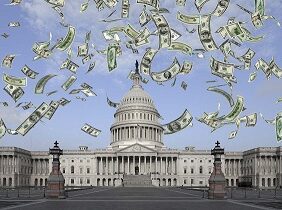On April 27, members of the Interior, Environment and Related Agencies Subcommittee of the House Appropriations Committee questioned Forest Service Chief Randy Moore on his agency’s budget request for fiscal year (FY) 2023. The discussion touched on many issues but focused on the Forest Service spending to mitigate and combat wildfires.
The U.S. Forest Service (USFS) budget requested over $8.95 billion in discretionary spending for FY2023, a 14.5% increase from the $7.82 billion enacted level for this year. In particular, USFS increased its requested funding for Wildfire Management by 17.6%, most of which can be attributed to increases in firefighter salaries and training to create a year-round workforce. Chief Moore told the subcommittee that USFS has hired 90 percent of the 11,400 people it aimed to add to the wildfire fighting force and will continue to hire more or enlist contractors.
As we noted when the budget request was released, scrutinizing FY2023 numbers alone doesn’t illuminate much because the Bipartisan Infrastructure Law (BIL) made significant investments in wildfire-related work, authorizing nearly $3.37 billion for wildfire risk reduction and $2.13 billion for ecosystem restoration. Lawmakers seem to agree Infrastructure bill funding should be taken into account. Rep. Josh Harder (D-CA) asked about the $321 million requested for hazardous fuels, which comes on top of $514 million that Congress already appropriated for FY2022-FY2026 through the BIL. Chief Moore answered that a California fire last year had burned through small areas previously treated for hazardous fuels and more funding would allow USFS to treat acreage on a bigger scale to reduce wildfire risk more effectively.
The issue of timber sales and vegetation management in national forests also came up during the hearing. Rep. Derek Kilmer (D-WA) asked about FY2023 target timber sales for the Olympic National Forest, which in the prior year had “failed to produce harvest levels to support the local timber industry and forest health.” But the truth is timber sales in national forests consistently generate less revenue than they cost to prepare and conduct, meaning taxpayers are losing money selling timber from federal lands.
TCS estimated that in the Tongass National Forest in Alaska, USFS has lost more than $1.7 billion from FY1980 to FY2019 on timber sales. Although the USFS did not request an increase to the FY2023 budget for Forest Products, many other programs that got a boost like the Collaborative Forest Landscape Restoration contribute to the administration of timber sales as well.
The USFS should make sure that its forest management programs don’t work at cross-purpose with each other. The USFS is focused on mitigating the increasing intensity of climate change-fueled wildfires, but they’ve also been subsidizing the felling of old trees that sequester carbon and reduce emissions. The Biden Administration launched efforts to inventory old-growth and mature forest, but Chief Moore did not provide more details when asked how USFS would define such trees by Chairwoman Chellie Pingree (D-ME). Furthermore, programs that subsidize biomass energy sources and related industries (sawmills, biochar plants, paper manufacturers, etc.) like the Community Wood Energy Program and the Wood Innovation Grants Program might increase – instead of decrease – GHG emissions without any GHG reduction criteria.
In the coming months, TCS will continue to follow how USFS implements billions of dollars’ worth of BIL funding in wildfire risk reduction. Just like the Subcommittee Ranking Member Dave Joyce (R-OH) said in his opening statement, Congress should engage in active oversight of the spending to ensure that there’s value for taxpayers and our natural resources without waste, fraud, and abuse.











Get Social